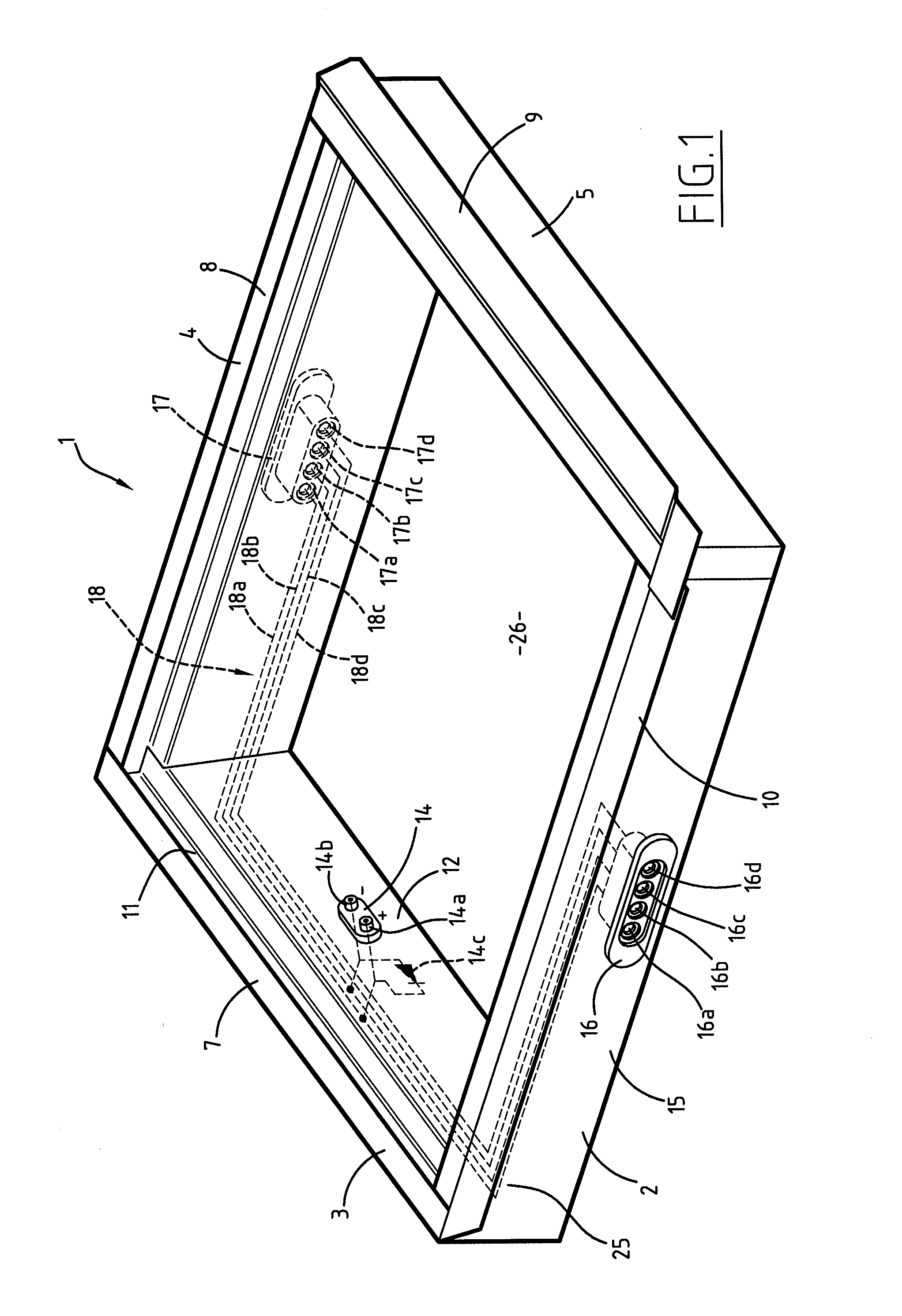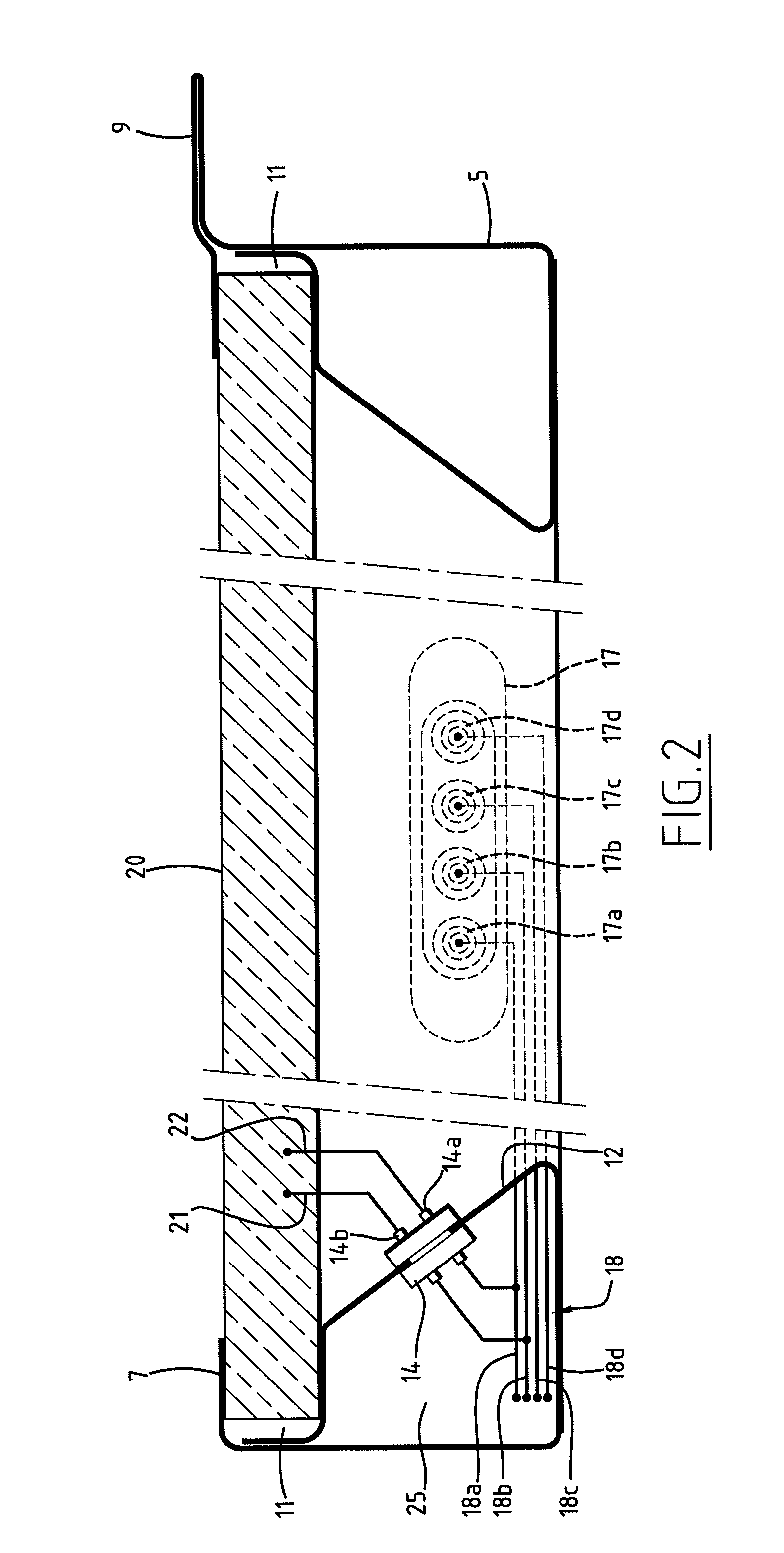Bearing frame for an electrically active panel such as photovoltaic panel
a technology of photovoltaic panels and supporting frames, which is applied in the direction of solar heat collector details, sustainable buildings, lighting and heating apparatus, etc., can solve the problems of unsuitable panels for such use, particularly unsightly cable bundles, and other electrically active problems
- Summary
- Abstract
- Description
- Claims
- Application Information
AI Technical Summary
Benefits of technology
Problems solved by technology
Method used
Image
Examples
first embodiment
[0085]FIG. 6 shows an assembly. In this figure, a first group 52 of two panels 53, 54 mounted in series and a second group 55 of two panels 56 and 57 also mounted in series is provided on the roof 51 of the building 50. The two groups of panels 52 and 55 are connected in parallel to a circuit 63 for powering a load. To produce an assembly of this type, the external connection means 53a of the panel 53 located at the end of the group 52 comprises a connection means 61 for connecting a circuit linked to the positive pole of the photovoltaic generator of the panel 53 to a return circuit.
[0086]Similarly, the external connector 53b of the framework 53 and the external connector 54a of the panel 54, which face one another, are connected by an intermediate connection means 60 which enables the positive pole of the generator of the panel 54 to be connected to the negative pole of the generator of the panel 53, and the return circuit of the panel 53 to the return circuit of the panel 54.
[008...
second embodiment
[0091]In a second embodiment, shown in FIG. 7, a first group 72 of panels 73 and 74 which are connected in parallel and a second group 75 of panels 76 and 77 which are also connected in parallel is disposed on the roof 71 of a building 70. The panels 73, 74 are connected in parallel via an intermediate connector 78. Similarly, the panels 76, 77 are connected in parallel via a connector 81.
[0092]Sets of panels 72 and 75 are connected in series with the load circuit via connectors 79 and 82 which link them on the one hand to a line 82 for connection of the positive poles of the unit 75 to the negative poles of the unit of panels 72. A line 83 corresponding to the positive pole of the load circuit is linked to the positive pole of the panels 73 and 74 via a connector 79. A line 84 corresponding to the negative pole of the load circuit is linked via the connector 82 to the negative pole of the panels 76 and 77.
[0093]Assemblies of this type, which are given by way of non limiting example...
third embodiment
[0107]the connector, shown in FIG. 12, may be used to produce connections of the type of connections 78, 79, 81 or 82 shown in FIG. 7, for producing junctions between two adjacent panels or of one panel with the load circuit when two adjacent panels are connected in parallel.
[0108]This connector 160 includes on the one hand studs 161, 162, 163 and 164 and on the other hand studs 165, 166, 167 and 168.
[0109]The studs 163 and 167 which face one another are linked by a conductive joining means 169 and the studs 164 and 168 which face one another are linked to one another by a conductive joining means 170.
[0110]The studs 163 and 164, on the one hand, and 167 and 168, on the other hand, are combined in a single unit made of plastics material also so as to produce a means of recognizing connection means.
[0111]The connectors which have just been described comprise four pairs of studs, only three of which are used.
[0112]However, the fourth pair of studs may also be used, for example, for ea...
PUM
 Login to View More
Login to View More Abstract
Description
Claims
Application Information
 Login to View More
Login to View More - R&D
- Intellectual Property
- Life Sciences
- Materials
- Tech Scout
- Unparalleled Data Quality
- Higher Quality Content
- 60% Fewer Hallucinations
Browse by: Latest US Patents, China's latest patents, Technical Efficacy Thesaurus, Application Domain, Technology Topic, Popular Technical Reports.
© 2025 PatSnap. All rights reserved.Legal|Privacy policy|Modern Slavery Act Transparency Statement|Sitemap|About US| Contact US: help@patsnap.com



